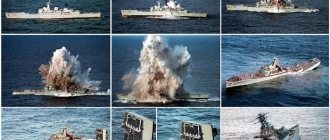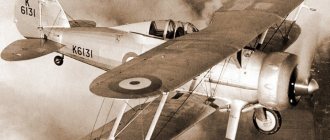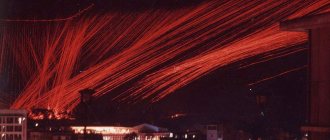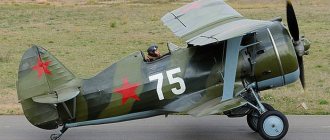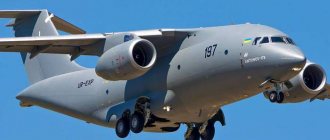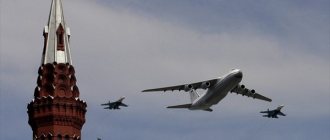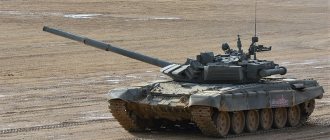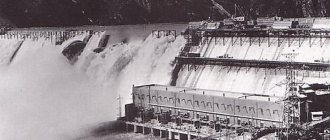Leading military developers from different countries, almost simultaneously, in the 1980s...90s of the last century, came to the idea of the need to create a medium multi-role fighter. This is how the Eurofighter Typhoon project appeared in Europe, and work began on the future MiG-35 in the USSR. However, French military designers felt that they needed a lighter aircraft capable of performing the same functions and carrying almost the same weapons.
France refused the further participation of its companies in the pan-European project Eurofighter 2000 (Typhoon) and Dassault Aviation began developing the Shkval fighter, which later became famous as the Dassault Rafale ─ a formidable fourth-generation multi-purpose air vehicle, entirely developed by the French.
History of creation
The Rafale, a French combat aircraft, appeared due to differences in the military doctrines of Western countries: Germany and England wanted to see the Eurofighter 2000 as a powerful air defense weapon, the latest interceptor, and France preferred to develop an aircraft that could replace the assault Mirages of the 2000 D/N series " or Étendard, Etander (also developed by ).
The newest fighter and attack aircraft was to be used not only in defense, but also to gain air supremacy, assault strikes on ground targets, and gain air superiority.
Development of the new “Combat Experimental Aircraft” (French “Avionde Combat Experimentale” or ACX) began at the company that produced the Etanders even before France left the pan-European Eurofighter program.
The condensed history of the emergence of one of the best multi-purpose air vehicles of our time can be represented as follows:
- 1983, begins development of a multi-role fighter based on the “Tactical Military Aircraft”;
- 1985, the project is given the name "ASH";
- 1986, Avion de Combat Experimentale makes its first test flight;
- 1987, the project receives the name Rafale-A and the same French turbojet engine;
- 1990, developed and tested single-seat Rafale C (from “Chasseur”, “hunter”, as fighters are called in France) and Rafale-B (double);
- 1991, test flights with landing on an aircraft carrier of the Rafale M fighter with reinforced landing gear from Bugatti (Messier-Bugatti).
Somewhere around 91-95, the multi-purpose Rafale ceased to be completely French, a small but important imported part appeared: the Martin-Baker Mk.16 (US16E) ejection seat, this model developed at Lockheed was better than any French analogues.
Since 1996, large-scale production of the Dassault Rafale began for both the Air Force and the French Navy; in 2004 (Navy) and 2006 (Air Force), the aircraft entered service with the Fifth Republic.
The Arabs deceived the Russians: Why does the UAE checkmate the Su-75 by purchasing the Rafale?
The French press rejoices. Of course: on December 3, it was announced that on the first day of French President Emmanuel Macron to Dubai, a record contract worth more than $19 billion (17 billion euros) was signed for the supply of 80 Rafale fighter jets and 12 Caracal military transport helicopters to the United Arab Emirates ( UAE).
“Thirteen years of effort, with ups and downs, were needed to consolidate the success of the Rafale in the United Arab Emirates, a wealthy state with growing geopolitical influence that has established close relations with Paris,” writes TV5monde, for example. Publications in the same spirit appeared in other media of the Fifth Republic.
The Rafale fighters will be supplied by Dassault Aviation Group between 2027 and 2031, which will allow Abu Dhabi to “retire” the 60 Mirage 2000s purchased back in 1998. Note that Macron sold aircraft, a version of which has yet to be developed. We are talking about F4 standard vehicles, the appearance of which, according to the President of the Fifth Republic, marks a “technological, industrial and strategic leap” for France.
Fighter-bomber design
Rafale belongs to the class of single-fin aircraft, both engines are located at the rear. Made according to the “duck” or “tailless” aerodynamic model that had proven itself well on the Mirages. When creating Shkval, the military demanded two main things from the manufacturing company:
- the aircraft must be lighter than the common European one;
- be less noticeable to enemy radars.
The engineers from Dassault Aviation managed to achieve an elegant solution to the problems assigned to them when they decided to use three main materials for the body of the aircraft and its wings:
- titanium;
- aluminum-lithium alloys;
- Kevlar;
- carbon fiber;
- composites.
More than 20% of the parts (by weight more than 25%) of this aircraft are made of composites and carbon fiber. The result was not a mindless copying of American stealth technologies, but an elegant, purely European solution with impressive overall performance characteristics:
- wing area - 46 sq. m.;
- wingspan - only 11 m (which is significantly less than the same figure for MiGs or American multi-role fighters);
- length ─ 15.3 m;
- weight (empty plane) ─ 9 tons (sea, with the M index exactly 500 kg heavier);
- weight (maximum take-off) ─ 21.5 tons;
- height ─ 5.3 meters.
At the same time, the vehicle is capable of reaching speeds of up to 2 thousand km/h, rising to a practical height of more than 15 thousand meters and is technically capable of withstanding overloads of up to 9 g. Thus, the new multi-purpose vehicle is capable of performing supersonic flights and maneuvers at speeds of more than 1.4 M or over 1,700 km/h. The aircraft is equipped with a front horizontal tail for greater maneuverability during sharp turns in dogfights or avoiding anti-aircraft shells or air-to-air missiles.
The creators also provided space for spare fuel tanks, both suspended (PTB) and conformal (CTB). In the case of supersonic flight, external fuel tanks are provided with smaller volumes than for long-distance operations (1250 and 2000 liters, respectively).
An interesting feature of the aircraft was the location of the parabolic antennas of aviation radars: on interceptors they are installed mainly in the front, while fighters have more of them in the stern. On the Rafale, these schemes are successfully combined (later becoming common for multi-purpose projects of the fourth and “4+” generations).
Moreover, the radars of the French fighter have been equipped since 2012 with phased antenna arrays (PAA), both passive and active (AFAR), which increases its survivability.
In addition to traditional radar equipment, the aircraft is equipped with such an interesting system as SPECTRa, developed specifically for it. The name of this latest development stands for “Rafale Threat Protection and Prevention System.”
It includes a system of infrared sensors that warn of radar and laser radiation from a fighter. And even equipment capable of suppressing enemy electronic warfare equipment and laser illumination.
French multirole fighter Dassault Rafale
Dassault Rafale is a French 4th generation multi-role fighter aircraft developed by Dassault Aviation. This machine is a completely French project - engines, weapons, avionics, as well as its own production and is currently the last aircraft created without American or other foreign help. Development of the Rafale aircraft began in 1983, 2 years before France officially withdrew from the program to create a promising European fighter FEFA, which was later called Eurofighter 2000. Rafale, like the Eurofighter, is intended for use as a strike fighter-bomber and interceptor , capable of performing air superiority and air defense missions, as well as bombing ground targets.
In 1983, the Avion de Combat Experimentale (ACX) experimental combat aircraft was developed as part of a national program. France withdrew from the EFA project because its armed forces, and especially the navy, wanted to get a compact and light vehicle, the mass of which was about 8 thousand kg. The ACX demonstration prototype weighing 9.5 thousand kg was being completed at that time. It first flew on July 4, 1986, and helped test the aerodynamic design, performance, configuration, fly-by-wire system, and extensive composite design for the Avion de Combat Tactique project.
The ACX was later renamed Rafale A. It was initially powered by two General Electric F404-GE-400 bypass turbojet engines. After 460 test flights, which included landing on the deck of the aircraft carrier Clemenceau (touch and go-around), one engine (left) was replaced with the SNECMA M88-2, which was developed specifically for the Rafale.
The Rafale fighter was made according to the “duck” design, has a mid-mounted delta wing, with a high-mounted front horizontal tail. The wing is equipped with two-section slats and single-section elevons.
The main material for the wing is carbon fiber. The tips of the consoles and the fairing at the junction of the wing and fuselage are made of Kevlar; the slats are made of titanium alloys. 50% of the fuselage is made of carbon fiber; Aluminum-lithium alloys are used for the side casing panels. In total, in the Rafale airframe design, composites account for 20% by area and 25% by weight. As a result, the weight of the airframe decreased by 300 kilograms.
A deck-based version of the fighter was developed for the French Navy, designated Rafale M. It is distinguished by a reinforced chassis and airframe design, the presence of a brake hook under the rear fuselage, a built-in retractable ladder, and so on. The Telemir system is installed at the end of the keel, which ensures the exchange of data between the aircraft carrier's navigation equipment and the aircraft's navigation system. As a result of all modifications, the Rafale M fighter became 500 kg heavier than the Rafale C.
Rafale aircraft are equipped with landing gear manufactured by Messier-Dowty. On Rafale modifications C and B, the main supports have one tire each, and the front one has two tires. On the decked Rafale M, the front support is self-orienting. When towing, it rotates almost 360 degrees.
On Rafale fighters, all supports are retracted forward. All wheels are equipped with carbon brakes manufactured by Messier-Bugatti.
On single-seat Rafale C and M, the cabin is equipped with a Martin-Baker Mk.16 ejection seat, which ensures safe exit of the aircraft on the ground when parked. The lantern opens to the right on side hinges. In the control cabin, the instrument panel houses three digital LCD multifunction displays. In the center is a tactical display that serves to display flight and navigation information and information received from various sensors. On the sides there are displays displaying information about the operation of engines, hydraulic, fuel, oxygen and electrical systems, as well as other equipment.
The Rafale's power plant is two Snecma M88-2E4 bypass turbojet engines. The thrust of each is 4970 kgf (in afterburner mode - 7445 kgf). For Snecma, developing the M88 engine was quite a difficult task. The customer needed an engine capable of operating reliably during maneuverable air combat and during a high-speed breakthrough of the air defense system at low altitude. Those. the requirements included a long service life, low fuel consumption in various flight modes and a high thrust-to-weight ratio. Snecma chose a twin-shaft engine, which was later to become the ancestor of the third generation of French-made engines.
The M88 engine development program officially began in 1986. In February 1989, the first bench test of the engine took place, and in February 1990, flight tests began on the demonstration Rafale A. Final certification occurred in 1996.
To obtain an engine with high performance, the developers used various advanced technologies in the engine design. For example, compressor disks were made monolithically with blades, monocrystalline blades were used in the design of a high-pressure turbine, and powder technology was used to produce turbine disks. The engine design uses ceramic coatings, a low-emission combustion chamber and composite materials. The creators of the turbofan engines were tasked with ensuring the minimum possible thermal signature of the fighter and reducing smoke in order to reduce visual signature.
A multi-stage approach was used to create the engine.
On single-seat fighters Rafale C and M, 5900 liters of fuel are stored in the internal tanks, and on two-seat Rafale B - 5300 liters. On 5 of the 14 external suspension units it is possible to accommodate external fuel tanks of various capacities. Fuel tanks with a capacity of 1250 liters are suspended on 4 underwing units, and on the central one - with a capacity of 2000 liters.
Rafale aircraft are armed with a 30-mm Nexter DEFA 791B cannon with a rate of fire of 2,500 rounds per minute. Ammunition - 125 armor-piercing incendiary tracer cartridges OPIT with a bottom fuse.
The missile armament consists of: - air-to-air missiles: AIM-9, AIM-132, AIM-120, MICA, Magik II, MBDA Meteor; — air-to-surface missiles: Apache, Storm Shadow, AM.39, AASM, ASMP with a nuclear warhead.
Tests and combat use
The experimental Rafale A fighter made its first flight in July 1986. The first aircraft in the Rafale C variant (single-seat fighter-interceptor) took off in May 1991, and the first carrier-based Rafale M aircraft, intended for arming French aircraft carriers, took off in December of the same year. According to the serial production plan, 86 and 235 aircraft will be delivered to the French Navy and Air Force, respectively.
The first combat use of the Rafale took place in March 2007 during the NATO operation in Afghanistan. In addition, these aircraft, starting in March 2011, were used in the NATO operation in Libya against Gaddafi’s troops.
The operation of the Rafale was not without incident. On December 6, 2007, a Rafale B modification fighter carrying out a training flight, flying from the Saint-Dizier air force base, crashed at 18:30 near the village of Nevik (central France). The cause of the crash was a failure in the fly-by-wire flight control system. Captain Emmanuel Moruse - the pilot of the plane was killed.
On September 24, 2009, two Rafale M modification fighters, 30 kilometers from the city of Perpignan, fell into the Mediterranean Sea as a result of a collision. The accident occurred at 18:10, during the return of the vehicles to the aircraft carrier Charles de Gaulle. The cause of the disaster, according to the Accident Investigation Bureau of the Ministry of Defense, was human error. The pilot of one fighter, captain second rank Francois Duflo, was killed. The pilot of the second, captain of the third rank Jean Beaufil, ejected.
On November 28, 2010, a Rafale M modification fighter, returning to the Charles de Gaulle, fell into the Arabian Sea after completing a combat mission to support coalition forces in Afghanistan. The accident happened 100 kilometers off the coast of Pakistan. The reason was a technical malfunction. The ejected pilot was picked up by a rescue helicopter.
On July 2, 2012, a French Rafale carrier-based fighter crashed during a training exercise. The incident occurred in the Mediterranean Sea with a vehicle based on the Charles de Gaulle. The pilot ejected and was picked up by an American helicopter. Joint exercises of French and American aircraft carriers were carried out in the Mediterranean.
The Rafale is in service with the French Air Force and Navy. The Air Force accepted the aircraft into service in 2006. As of 2012, 38 Rafale B and 37 Rafale C vehicles were accepted.
The navy adopted the Rafale M in 2004. As of 2012, there were 36 aircraft.
In addition, Rafale won the Indian tender and took part in tenders for the supply of fighters to Brazil and the UAE. On January 31, 2012, Rafale won the international MMRCA tender
Modifications:
Rafale A – experimental demonstration Rafale. It was slightly larger and heavier compared to the Rafale C/M aircraft. It was equipped with a pair of F404-GE-400 engines with a thrust of 6800 kg (16 thousand pounds), on their basis the M88 engine was developed. Rafale B – two-seater, ground-based. It was ordered as a training version of the Rafale C, with all functionality retained. Rafale C is a multi-role land-based combat aircraft. Originally designated Rafale D, renamed in 1990. The French Air Force requested 250 aircraft in single and double versions. Rafale M is a carrier-based single-seat multi-role aircraft. Similar to the Rafale C, but equipped with a landing hook, as well as a modified nose strut with variable length. The Navy requested 86 vehicles.
Flight characteristics of Rafale:
Crew – 1-2 people; Aircraft length – 15.3 m; Height – 5.3 m; Wing span – 10.9 m; Wing area – 45.7 m²; Empty aircraft weight – 10,000 kg; Normal take-off weight – 14710 kg; Maximum take-off weight – 24500 kg; Payload weight – 9500 kg; Fuel weight – 4700 kg; Fuel mass in outboard fuel engines – 6700 kg; Engine – 2 two-circuit turbojet SNECMA M88-2 with afterburner; Dry engine weight – 897 kg; Maximum thrust – 5100 kgf for each engine; Afterburner thrust - 7500 kgf for each engine; Gas temperature in front of the turbine – 1577 °C; Maximum speed – Mach 1.8 (1900 km/h); Combat radius (in the fighter-interceptor version) - 1093 km; Combat radius – 1800 km Service ceiling – 15240 m; Rate of climb – 305 m/s.
Prepared from materials: https://ru-aviation.livejournal.com https://worldweapon.ru https://3mv.ru https://www.be-and-co.com https://www.airwar. ru https://crimso.msk.ru
Armament
The main armament is an automatic revolver aircraft cannon of the Nexter DEFA 791B type with only 125 rounds of ammunition. But they use it extremely rarely. But missile weapons allow Shkval to avoid resorting to this “final argument” for as long as possible.
Can carry air-to-air missiles of the following types:
- French short-range missile MICA;
- American Saunder or AIM-9 with infrared guidance head;
- American mid-range Slammer AIM-120;
- English infrared homing ASRAAM (AIM-132) for short range;
- cutting-edge Magique-II or Meteor missiles.
These are weapons for air combat and achieving air superiority. For attacking ground targets the following can be installed:
- Anglo-French aircraft cruise missiles Storm Shadow (“Storm Threat”);
- air-to-surface missiles such as Apache, AM-39 or ASMP, the latter of which can be equipped with a nuclear warhead.
On a combat mission, the multirole fighter is capable of carrying 12 bombs and from 8 to 12 (depending on type) missiles.
As intended, the Dassault Rafale is perfectly armed both for air combat and for attacking and suppressing ground targets.
The first modernized Rafale M fighter for the French Air Force
Dassault Rafale - multi-role fighter
Development of the aircraft began in 1983, two years before France's official withdrawal from the program to create a promising European FEFA fighter, later called Eurofighter 2000.
Dassault Rafale is a multi-role fighter / Photo: upload.wikimedia.org
Like the Eurofighter, the Rafale is designed for use as an interceptor and strike fighter-bomber capable of performing air defense and air superiority missions, as well as striking ground targets.
The first flight of the experimental Rafale A fighter took place in July 1986. The first experimental aircraft in the version of the single-seat fighter-interceptor Rafale C took off in May 1991, and the first experimental carrier-based aircraft intended for arming French aircraft carriers, Rafale M, took off in December 1991. Serial production plans provide for the delivery of 235 and 86 aircraft to the French Air Force and Navy, respectively.
Photo: upload.wikimedia.org
Modifications:
• Rafale A: prototype of the Rafale aircraft. It was slightly larger and heavier than the Rafale C/M and was powered by two 6,800 kg (16,000 lb) thrust F404-GE-400 engines, from which the M88 engine was developed. • Rafale B: a prototype, ordered as a two-seat trainer version of the Rafale C aircraft, but retaining all the functionality. • Rafale C: two prototypes ordered as single-seat multi-role combat aircraft. The first aircraft, ordered in April 1988, flew in February 1991. Originally designated Rafale D, the French term for stealth aircraft, it was renamed Rafale C in 1990. The French Air Force requested 250 aircraft. in single and double versions. • Rafale M: two prototypes ordered for the French Navy as a carrier-based single-seat multi-role aircraft designated Rafale M. Similar to the Rafale C, but equipped with a landing hook and a modified variable-length nose strut. The Navy requested 86 vehicles.
Photo: upload.wikimedia.org
Tactical and technical indicators
| Specifications | |
| Crew, people | 1-2 |
| Wingspan, m | 10,8 |
| Aircraft length, m | 15,3 |
| Aircraft height, m | 5,34 |
| Wing area, sq.m | 46 |
| Weight, kg: | empty - 10500 maximum take-off - 24500 |
| Fuel, kg: | internal - 4500 PTB - 7500 |
| Engine | 2 SNECMA M88-3 turbojet engines |
| Maximum thrust, kgf | 2 x 8870 |
| Maximum speed, km/h: | cruising - 1100 maximum combat - 1390 maximum at an altitude of 11000 - 2125 |
| Rate of climb, m/min | 3700 |
| Practical ceiling approx. m | 20000 |
| Combat range, km: | as an attack aircraft - 1100 as an interceptor - 1800 |
| Maximum operational overload | 9 |
Armament:
1 30 mm GIAT M30/719B cannon. Combat load - 9500 kg on 14 hardpoints. 1 x 900 kg ASMP short-range nuclear missile (100-150 kilotons). As an interceptor:
9 SD air-to-air MICA or 6 SD + 2 PTB.
As an attack aircraft:
16 x 250 kg bombs, 2 MICA air-to-air missiles + 2 PTBs or 2 APACHE launchers, 2 MICA air-to-air missiles + 2 PTBs or 2 x 400 kg BLG400 laser-guided bombs, 2 AS.30L air-to-ground missiles, 4 MICA air-to-air missiles, 1 PTB, 1 FLIR container + 1 ATLIS II container, 2 DEFA 791B containers with a 30-mm GIAT cannon (2500 rounds).
In the role of a naval attack aircraft:
2 AM.39 Exocet anti-ship missiles, 4 MICA air-to-air missiles + 3 PTB.
Modern modifications
At the moment, only 165 Rafales have been produced, and, as is required for a multi-purpose military aircraft, they differ quite greatly in “specialization”, since more than ten modifications of this formidable aircraft have been developed. However, apart from the models modified specifically for the Indian and Egyptian Air Forces (index “BM” and “DM” for the Egyptians and types “BH”, “DH” for the Indians), the main types of Dassault Rafale today are:
- single-seat, types “D” and “M” (land-based and sea-based, respectively);
- modification for naval forces of the Standard F2 type (in service since 2006);
- carrier-based double, with index N;
- aircraft for using nuclear missiles, with the index BM.
The first Shkvals also fall into this classification, but Rafale types “A” and “B” are no longer produced, and the Rafale C variant, erroneously mentioned on most sites, has long been renamed Rafale D.
Combat use
The Dassault Rafale, along with the aging Mirages and other Western carrier-based aircraft, tested its strength in the Western allied combat operation in Afghanistan (the first baptism of fire for the land-based D-type Shkval) and in the allied invasion of Libya.
During the last combat operation, an event publicized by the Western media took place: as part of the combat aviation of the Western allies, carrier-based Rafale M multirole fighters destroyed six twenty-third MiGs and two Crocodiles (MI-35 helicopters).
Later, information appeared that these interceptors and attack helicopters of our production were indeed destroyed by Rafales, but during the attack on the airfield, and not in the air. So Rafal has not yet been able to meet a real and serious air enemy (as well as the latest Russian or American multi-purpose aircraft).
Currently, the carrier-based M type is actively used on board the flagship of the French Navy, the nuclear-powered aircraft carrier Charlesde Gaulle, in the Syrian campaign against ISIS.
It is curious that the same “pan-European” Super-Etanders that France at one time refused to work on, and not Rafale, are used as attack aircraft on the Charles de Gaulle.
An interesting fact is that, despite four disasters in which five Dassault Rafales were irretrievably lost (in one of the incidents two such fighters collided), there are reports that any Shkval was shot down in a combat situation, like our Su -24 in 2015, not reported.
All accidents with French "sky hawks" occurred due to technical problems, or due to the inattention of the pilot, like the last disaster in the joint French-American exercises of 2012.
Comparative performance characteristics and performance characteristics according to the Indian salon 2012
The successful multi-purpose Dassault Rafale has firmly entered the history of aircraft manufacturing and the development of the world Air Force. This was proven, in particular, by the victory of designers from Dassault Aviation over American military aircraft manufacturers from Lockheed and Boeing, as well as over the Russian MiG bureau at a commercial exhibition in India in 2012.
A detailed table of data on the Indian Air Show 2012, the technical and flight characteristics of the Rafale in comparison with other, also very well-known brands of air combat vehicles of the same class:
| A country | France | USA | USA | Russia | Other |
| Name | Dassault Rafale | F-16 Fighting Falcon | F/A-18E/F Super Hornet | MiG-35 | Eurofighter Typhoon |
| Length, m. | 15,30 | 15,03 | 18,31 | 18,31 | 15,96 |
| Wingspan, m. | 10,90 | 10,00 | 13,62 | 12,00 | 10,95 |
| Wing area, sq.m. | 45,7 | 27,9 | 46,5 | 30,0 | 50,0 |
| Combat load, kg. | 9500 | 7800 | 8050 | 7000 | 7500 |
| Weight (empty plane), kg. | 10000 | 9979 | 14552 | 11000 | 11000 |
| Pendants with weapons | 14 (5 for heavy weapons) | 11 | 11 | 10 | 13 |
| Maximum thrust in afterburner, kN. | 2x75 | 1x144 | 2x98 | 2x88.3 | 2x90 |
| Maximum thrust, kN. | 2x50 | 1x84 | 2x62 | 2x53 | 2x90 |
| Max. speed at altitude, M. | 1,8 | 2,0 | 1,8 | 2,25 | 2,25 |
| Combat radius, km. | 1389 | 550 | 722 | 1000 | 1390 |
| Practical ceiling, m. | 15.240 | 18.000 | 15.000 | 17.500 | 19.812 |
| Cost (per year of the salon, $ million) | 85-124 | 50 | 55 | 45 | 120 |
When comparing the numbers, even without a calculator, it is clear that the creators of the Rafale were able to achieve a golden mean between the weight of the aircraft, its armament and flight performance. And unlike the MiG-35 or Fighting Falcon, to which complaints arose, the Rafale was able to confirm all design characteristics on test flights.
Dassault "Rafale", Fighter
Dassault Rafale is a French 4th generation multi-role fighter aircraft developed by Dassault Aviation. This machine is a completely French project - engines, weapons, avionics, as well as its own production and is currently the last aircraft created without American or other foreign help. Development of the Rafale aircraft began in 1983, 2 years before France officially withdrew from the program to create a promising European fighter FEFA, which was later called Eurofighter 2000. Rafale, like the Eurofighter, is intended for use as a strike fighter-bomber and interceptor , capable of performing air superiority and air defense missions, as well as bombing ground targets.
In 1983, the Avion de Combat Experimentale (ACX) experimental combat aircraft was developed as part of a national program. France withdrew from the EFA project because its armed forces, and especially the navy, wanted to get a compact and light vehicle, the mass of which was about 8 thousand kg. The ACX demonstration prototype weighing 9.5 thousand kg was being completed at that time. It first flew on July 4, 1986, and helped test the aerodynamic design, performance, configuration, fly-by-wire system, and extensive composite design for the Avion de Combat Tactique project.
The ACX was later renamed Rafale A. It was initially powered by two General Electric F404-GE-400 bypass turbojet engines. After 460 test flights, which included landing on the deck of the aircraft carrier Clemenceau (touch and go-around), one engine (left) was replaced with the SNECMA M88-2, which was developed specifically for the Rafale.
The Rafale fighter was made according to the “duck” design, has a mid-mounted delta wing, with a high-mounted front horizontal tail. The wing is equipped with two-section slats and single-section elevons.
The main material for the wing is carbon fiber. The tips of the consoles and the fairing at the junction of the wing and fuselage are made of Kevlar; the slats are made of titanium alloys. 50% of the fuselage is made of carbon fiber; Aluminum-lithium alloys are used for the side casing panels. In total, in the Rafale airframe design, composites account for 20% by area and 25% by weight. As a result, the weight of the airframe decreased by 300 kilograms.
A deck-based version of the fighter was developed for the French Navy, designated Rafale M. It is distinguished by a reinforced chassis and airframe design, the presence of a brake hook under the rear fuselage, a built-in retractable ladder, and so on. The Telemir system is installed at the end of the keel, which ensures the exchange of data between the aircraft carrier's navigation equipment and the aircraft's navigation system. As a result of all modifications, the Rafale M fighter became 500 kg heavier than the Rafale C.
Rafale aircraft are equipped with landing gear manufactured by Messier-Dowty. On Rafale modifications C and B, the main supports have one tire each, and the front one has two tires. On the decked Rafale M, the front support is self-orienting. When towing, it rotates almost 360 degrees.
On Rafale fighters, all supports are retracted forward. All wheels are equipped with carbon brakes manufactured by Messier-Bugatti.
On single-seat Rafale C and M, the cabin is equipped with a Martin-Baker Mk.16 ejection seat, which ensures safe exit of the aircraft on the ground when parked. The lantern opens to the right on side hinges. In the control cabin, the instrument panel houses three digital LCD multifunction displays. In the center is a tactical display that serves to display flight and navigation information and information received from various sensors. On the sides there are displays displaying information about the operation of engines, hydraulic, fuel, oxygen and electrical systems, as well as other equipment.
The Rafale's power plant is two Snecma M88-2E4 bypass turbojet engines. The thrust of each is 4970 kgf (in afterburner mode - 7445 kgf). For Snecma, developing the M88 engine was quite a difficult task. The customer needed an engine capable of operating reliably during maneuverable air combat and during a high-speed breakthrough of the air defense system at low altitude. Those. the requirements included a long service life, low fuel consumption in various flight modes and a high thrust-to-weight ratio. Snecma chose a twin-shaft engine, which was later to become the ancestor of the third generation of French-made engines.
The M88 engine development program officially began in 1986. In February 1989, the first bench test of the engine took place, and in February 1990, flight tests began on the demonstration Rafale A. Final certification occurred in 1996.
To obtain an engine with high performance, the developers used various advanced technologies in the engine design. For example, compressor disks were made monolithically with blades, monocrystalline blades were used in the design of a high-pressure turbine, and powder technology was used to produce turbine disks. The engine design uses ceramic coatings, a low-emission combustion chamber and composite materials. The creators of the turbofan engines were tasked with ensuring the minimum possible thermal signature of the fighter and reducing smoke in order to reduce visual signature.
A multi-stage approach was used to create the engine.
On single-seat fighters Rafale C and M, 5900 liters of fuel are stored in the internal tanks, and on two-seat Rafale B - 5300 liters. On 5 of the 14 external suspension units it is possible to accommodate external fuel tanks of various capacities. Fuel tanks with a capacity of 1250 liters are suspended on 4 underwing units, and on the central one - with a capacity of 2000 liters.
Rafale aircraft are armed with a 30-mm Nexter DEFA 791B cannon with a rate of fire of 2,500 rounds per minute. Ammunition - 125 armor-piercing incendiary tracer cartridges OPIT with a bottom fuse.
The missile armament consists of: – air-to-air missiles: AIM-9, AIM-132, AIM-120, MICA, Magik II, MBDA Meteor; – air-to-surface missiles: Apache, Storm Shadow, AM.39, AASM, ASMP with a nuclear warhead.
Tests and combat use The experimental fighter Rafale A made its first flight in July 1986. The first aircraft in the Rafale C variant (single-seat fighter-interceptor) took off in May 1991, and the first carrier-based Rafale M aircraft, intended for arming French aircraft carriers, took off in December of the same year. According to the serial production plan, 86 and 235 aircraft will be delivered to the French Navy and Air Force, respectively.
The first combat use of the Rafale took place in March 2007 during the NATO operation in Afghanistan. In addition, these aircraft, starting in March 2011, were used in the NATO operation in Libya against Gaddafi’s troops.
The operation of the Rafale was not without incident. On December 6, 2007, a Rafale B modification fighter carrying out a training flight, flying from the Saint-Dizier air force base, crashed at 18:30 near the village of Nevik (central France). The cause of the crash was a failure in the fly-by-wire flight control system. Captain Emmanuel Moruse - the pilot of the plane was killed.
On September 24, 2009, two Rafale M modification fighters, 30 kilometers from the city of Perpignan, fell into the Mediterranean Sea as a result of a collision. The accident occurred at 18:10, during the return of the vehicles to the aircraft carrier Charles de Gaulle. The cause of the disaster, according to the Accident Investigation Bureau of the Ministry of Defense, was human error. The pilot of one fighter, captain second rank Francois Duflo, was killed. The pilot of the second, captain of the third rank Jean Beaufil, ejected.
On November 28, 2010, a Rafale M modification fighter, returning to the Charles de Gaulle, fell into the Arabian Sea after completing a combat mission to support coalition forces in Afghanistan. The accident happened 100 kilometers off the coast of Pakistan. The reason was a technical malfunction. The ejected pilot was picked up by a rescue helicopter.
On July 2, 2012, a French Rafale carrier-based fighter crashed during a training exercise. The incident occurred in the Mediterranean Sea with a vehicle based on the Charles de Gaulle. The pilot ejected and was picked up by an American helicopter. Joint exercises of French and American aircraft carriers were carried out in the Mediterranean.
The Rafale is in service with the French Air Force and Navy. The Air Force accepted the aircraft into service in 2006. As of 2012, 38 Rafale B and 37 Rafale C vehicles were accepted.
The navy adopted the Rafale M in 2004. As of 2012, there were 36 aircraft.
In addition, Rafale won the Indian tender and took part in tenders for the supply of fighters to Brazil and the UAE. On January 31, 2012, Rafale won the international MMRCA tender
Modifications: Rafale A – experimental demonstration Rafale. It was slightly larger and heavier compared to the Rafale C/M aircraft. It was equipped with a pair of F404-GE-400 engines with a thrust of 6800 kg (16 thousand pounds), on their basis the M88 engine was developed. Rafale B – two-seater, ground-based. It was ordered as a training version of the Rafale C, with all functionality retained. Rafale C is a multi-role land-based combat aircraft. Originally designated Rafale D, renamed in 1990. The French Air Force requested 250 aircraft in single and double versions. Rafale M is a carrier-based single-seat multi-role aircraft. Similar to the Rafale C, but equipped with a landing hook, as well as a modified nose strut with variable length. The Navy requested 86 vehicles. Rafale N is a two-seat carrier-based fighter-bomber.
| Modification | Rafale M |
| Wingspan, m | 10.80 |
| Aircraft length, m | 15.27 |
| Aircraft height, m | 5.34 |
| Wing area, m2 | 45.70 |
| Weight, kg | |
| empty loaded | 10460 |
| normal takeoff | 18500 |
| maximum takeoff | 22500 |
| Fuel, kg | |
| internal | 4500 |
| PTB | 7500 (1 x 3000 + 2 x 2000 l and/or 2 2 x 1300 l) |
| Engine | 2 SNECMA M88-2 turbofan engines |
| Maximum thrust, kN | |
| nominal | 2 x 73.23 |
| afterburner | 2 x 92.90 |
| Maximum speed, km/h: | |
| near the ground | 1350 |
| on high | 1900 |
| Practical range without PTB, km | 2000 |
| Combat radius, km | |
| as an attack aircraft | 1055 |
| as an interceptor | 1760 |
| Max. rate of climb, m/min | 19800 |
| Practical ceiling, m | 16765 |
| Max. operational overload | 9 |
| Crew, people | 1-2 |
| Weapons: | one 30-mm GIAT M30/719B cannon combat load – 9500 kg on 13 hardpoints |
A footprint in the skies of military history and computer games
Taking into account the results of the “Indian tender”, as well as the fact that of the ultra-modern multi-purpose military vehicles presented on it, only the Rafale took part in real military operations, we can say that this fourth-generation French fighter has already forever entered the history of aircraft manufacturing and military affairs .
It was on the basis of the Rafale that similar aircraft were built in Japan, India, China and Taiwan. True, in the Indian (code designation “Diamond”) and Taiwanese (Jingguo) versions, this unique device has lost its multi-purpose meaning and is produced exclusively as a fighter.
Particularly interesting is the joint project of China and Pakistan “Chengdu FC-1 Xiaolong” (Chengdu FC-1 Xiaolong), in the Pakistani classification - JF-17 Thunder.
Chinese and Pakistani aircraft designers have managed to successfully combine the advantages of Dassault Rafale and new developments based on Chinese modifications of the MiG-21!
The popularity of the multi-purpose Shkval is also proven by the fact that since 1997, aircraft of Rafale modifications have been constantly present in one of the most popular foreign computer flight simulators - Jane's Fighters Anthology.

